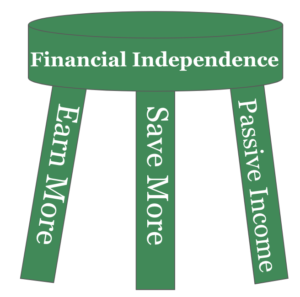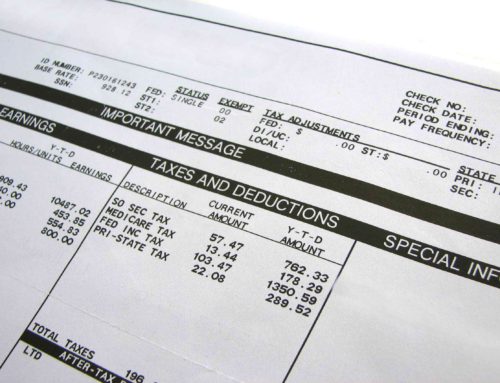When you hear about passive income, you probably think it sounds great. Well, you’re absolutely right! It is great. However, let’s talk about what it really is and why you need to ensure you understand how it actually works.
Financial independence means no longer having to trade your time for money. Traditionally, this is what society considered retirement. It meant you’d worked long and hard for 30+ years and along the way had saved enough of a nest egg to support yourself for your remaining golden years. It meant early tee times, afternoon naps, 5pm dinner buffets, and then falling asleep watching 60 Minutes. Then the FI community showed up and they were like, “Nah, that plan sucks. I don’t want to wait until I’m 65 to retire. We’re going to fix this!” The solution we came up with is pretty straightforward and only requires 3 actions:
Earning more and saving more are all about creating the biggest difference possible between what you make and what you spend. The wider this gap between income and cost of living, the more money you’ll accumulate and the sooner you’ll be able to call it quits and live off of that stockpile. The problem with only focusing on earning and saving is that you eventually reach a threshold. Your hourly pay or salary will cap at some point and you only have so much time to work side hustles before you burn out. On the saving side, you can only save so much before your quality of life makes you start to question whether it’s even worth it.

Enter the third leg of my metaphorical FI stool, passive income. Passive income is what will ultimately allow you the freedom you desire. With passive income, you can literally make money while you’re sleeping, while you’re relaxing on a beach on a Tuesday morning, while you’re booking your flight to another country on a whim, or even while you’re planning your next passion project. When your money is working for you instead of the other way around, a whole new world of possibilities is revealed and your time becomes your time again. Passive income is generated in many forms, but common strategies are real estate investments, online businesses, and investment dividends.

CAUTION: The concept of passive income revolves around you making money without having to physically work for it. Money just magically shows up in your virtual or physical inbox. However, this concept is somewhat misleading. Outside of the near 0% chance that you hit the lottery or the only slightly better chance that you’re left a fortune by a relative, there’s no such thing as 100% passive income. You will ALWAYS need to put the work in up front and potentially put some smaller amount of effort ongoing to maintain it.
One of the most popular forms of passive income is real estate investing, so let’s break it down. I’ll highlight here some of the general steps one would need to take to start generating “passive” income through real estate…

First, you need to find the property. This could be doing your own searching online, hiring a real estate agent, working with a broker, sending out mailers, or what some call driving for dollars. This is when you actively drive around a city trying to identify properties that may not be listed on the MLS, but the owners may be motivated to sell. These are usually the best deals. Then you move on to the evaluation stage. You’ve got to do the work to determine if it’s a good deal. This includes assessing the property itself and the area around it. Next is working the financing. Then there’s the negotiation and all of the associated closing paperwork. Once the property is acquired, if it was truly a good deal, it’s very likely that it needs some work. With this, enter an entirely new set of challenges around finding reliable contractors, planning the demo/construction project, or even more taxing, doing the work yourself. Once the property is ready to rent, you then need to do the work to find and vet a tenant. If you’re not doing it yourself, then you have to find and vet a property manager. If you’re managing the property yourself, be prepared to drop everything and address tenant needs (leaky dishwasher, AC not working, etc). Oh, don’t forget getting property insurance, setting up a method to collect rent, drafting the lease, and probably 50 other things I haven’t even mentioned here because this post is already getting too long.
The point is, the sum of these tasks has a significant cost in terms of time, effort and money. If I were to take the paragraph above out of context, I’m certain no one would classify that as passive income. And there’s the often unspoken component of passive income…the fact that a LOT of upfront work is required before you reach a state of near passivity. I say “near” because even after you’ve done the upfront work, I can’t think of anything (anything that’s done well anyway) that doesn’t require some level of ongoing maintenance. Take this blog, for example. One, it didn’t just show up overnight. It took nearly 2 years for me to take this from concept to reality. And two, it’s not static. I write new blog posts, refine existing content, respond to readers, and constantly try to find new ways to engage with my audience. So no, I’m not sitting at a desk from 9am to 5pm, but any income I generate from this blog isn’t fully passive either. For more on what goes into this blog and tips on starting a revenue generating blog of your own, check out this post on starting a blog.
Wrapping up, passive income can be a powerful tool in your financial toolbelt, but recognize that it doesn’t just happen without putting in the work up front. Once you’ve accepted this and you’re ready to add this weapon of passive income to the arsenal, check out these ideas for generating passive income. Until next time!






